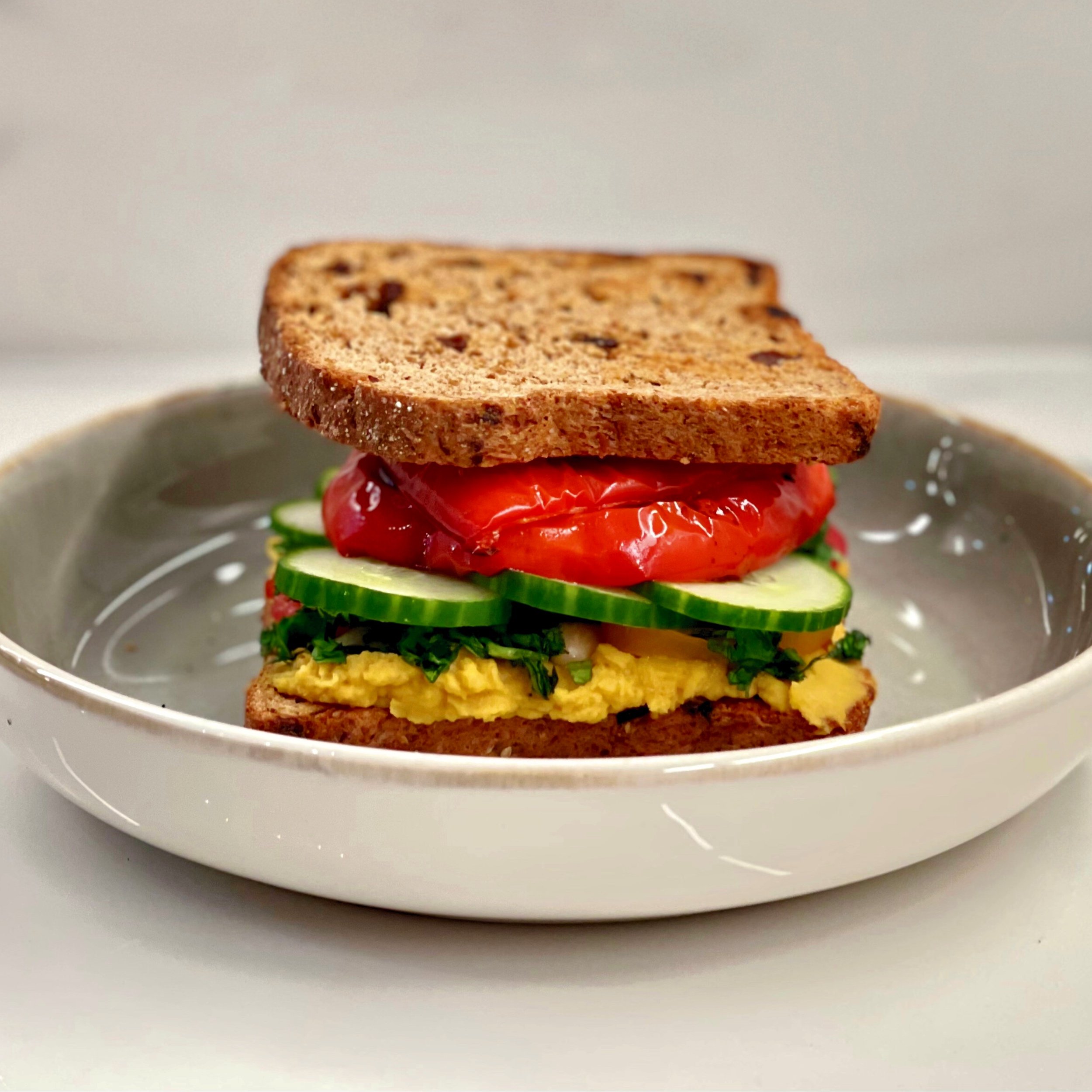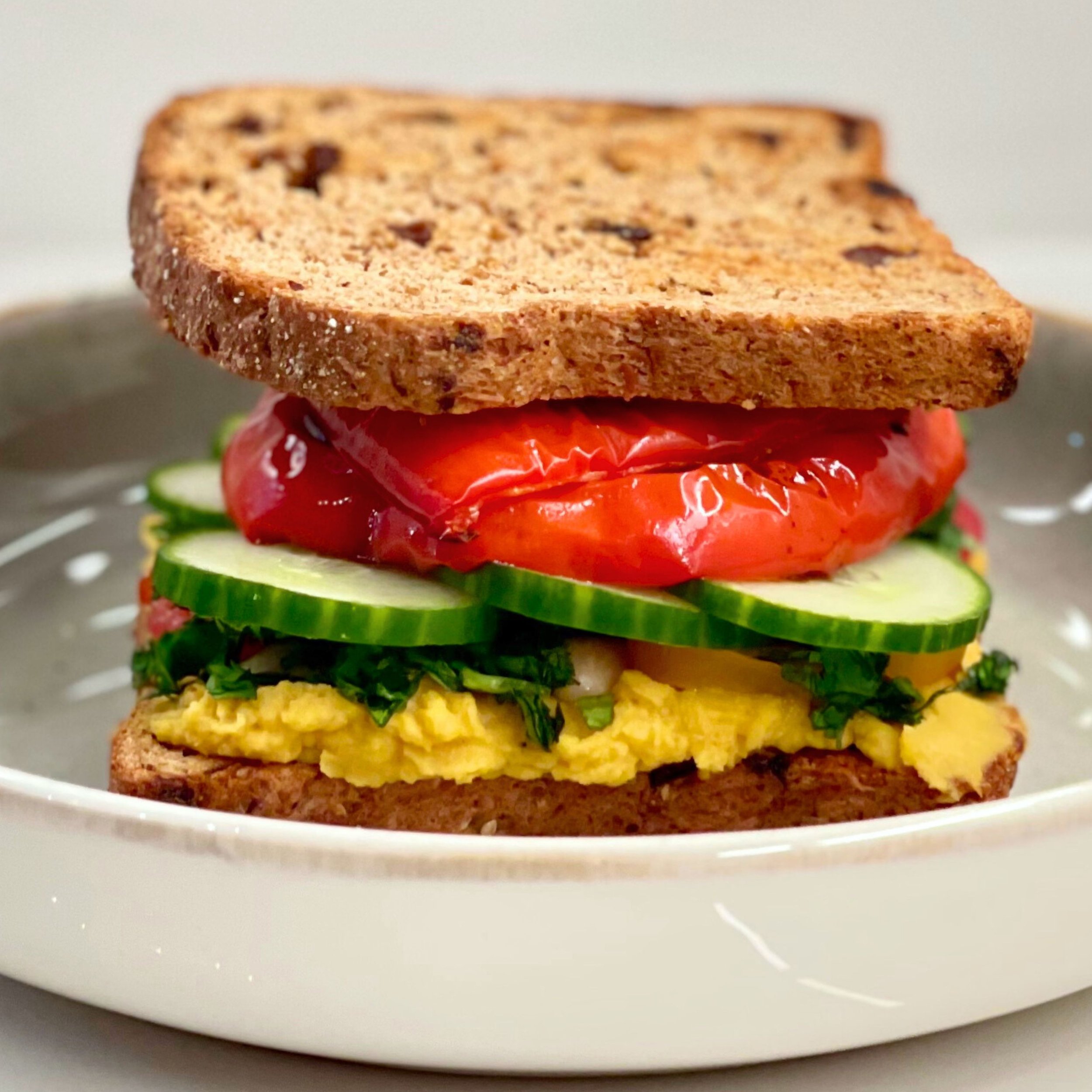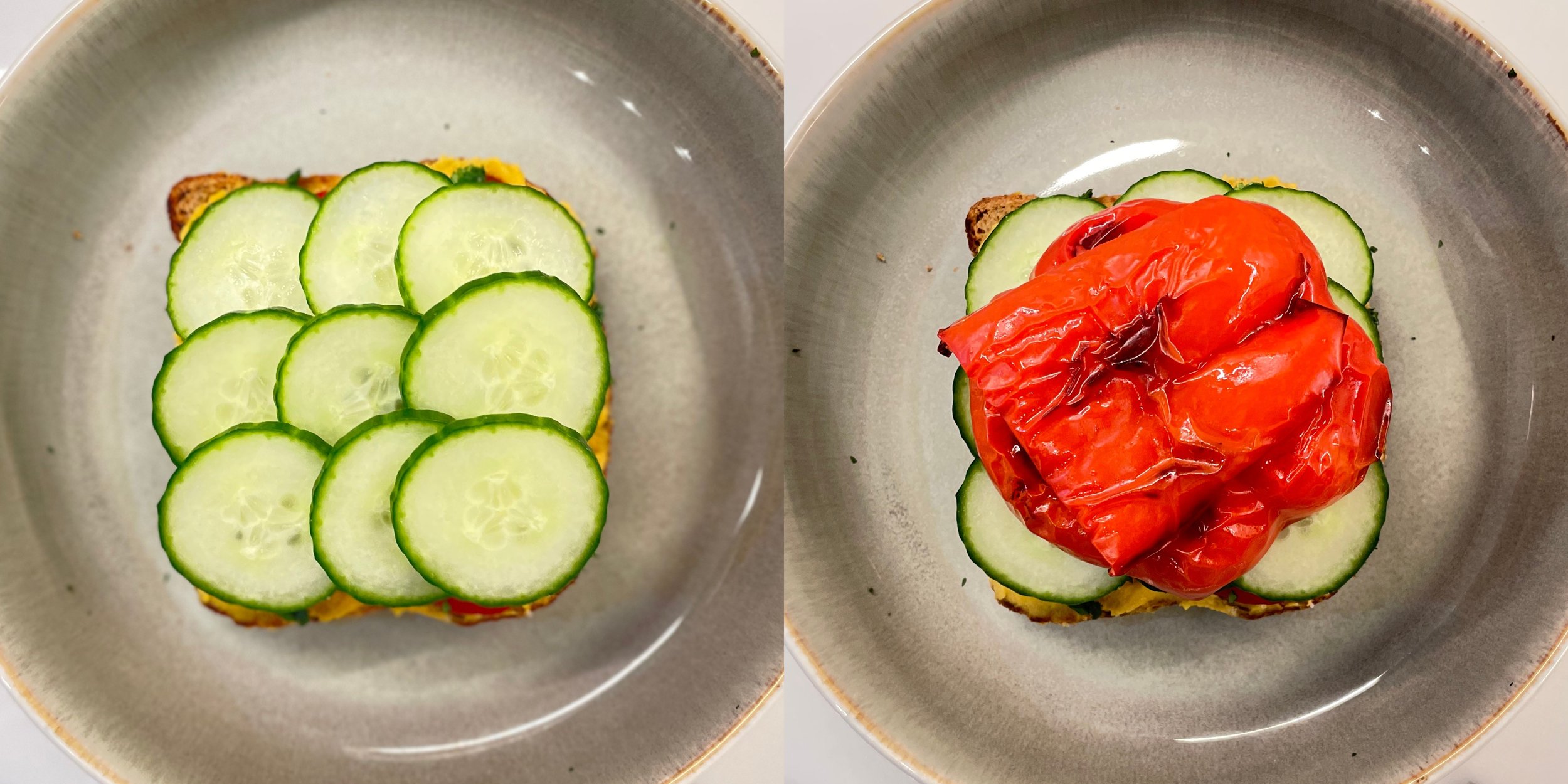Yogi Sandwich with Roasted Red Bell Pepper & Hummus
This sandwich is ideal as a midday lunch. Bell peppers roasted in olive help keep the flavors bright, even if the sandwich is prepared in advance and refrigerated overnight. Satiating hummus keeps you feeling full longer while almonds and cucumber add extra protein, hydration, and a satisfying crunch. Notes of salty and sweet round out a flavor profile that is decidedly gourmet. Even though the taste has all of the hallmarks of comfort food, the sandwich is light in the stomach, easy on digestion, and supportive of a healthy lifestyle.
A complete meal that’s perfectly portioned, this sandwich has all of the macro and micronutrients you need to keep you fueled until dinner. It’s extra satisfying during the summer months, as the sweet notes of the hummus, bell peppers, and almonds pacify inner and outer heat while tomatoes and cucumbers offer a boost to hydration. A generous topping of cilantro adds to the cooling effect. Plus, this sandwich’s sprouted grain bread means you don’t have to compromise on your digestion or feel guilty about a loss of nutrients!
Food for Thought: What Makes a Recipe Yogic?
We all know that our food impacts our physical health, state of mobility, overall flexibility, and energy levels. Yogis take it a step further to say that the quality of our thought is also directly related to the nature of our food. Certain foods will stimulate the nervous system and aggravate the mind, while others will create inertia in the body and lethargy in the mind. The yogic diet seeks a middle way, focusing on the principles of balance. The ideal diet for a yogi is one that supports the body by providing ojas (“vigor”, the vital energy underlying immunity and strength) without compromising the quality of the mind.
The Qualities of Food: Sattva, Rajas, Tamas
Food can be categorized into one of three qualities: Sattva, Rajas, or Tamas. Sattvic foods are light, healthy, and fresh; they promote mental clarity and are the preferred quality of food for yogis. Rajasic food stimulates the nervous system, increases motivation, and creates desires. Tamasic foods generate a lethargic, restful quality in the body and a dullness in the mind.
Even though yogis seek to eat predominately Sattvic food, it is key to understand that we need all three qualities to function; without Rajas, we wouldn’t be able to move a finger and without Tamas we wouldn’t be able to sit still for meditation. Also, your diet will vary depending on your constitution (the nature of your personality, energy levels, and body), state of digestion, and goals for spiritual practice. The diet of a karma yogi, someone who is vigorously active in the world, will look different from that of a hatha yogi, someone who is prioritizing long hours of steady postures, breathwork, and meditation. Finally, make note that preparation has much to do with the final quality of the food: food that is home-cooked with love and eaten immediately (versus reheated a day or two later), will have a higher quality of Sattva. The longer food sits in the fridge, the more it is imbued with the quality of Tamas.
For the purposes of our recipes, we strive to provide you with recipes that are Sattva-predominant, Vegetarian or Vegan, and Yogi-approved.
“Mind is made up of food.”
— Chandogya Upanishad
Go to...
i. Ayurvedic Ingredient Profileii. Nutrition Facts
iii. Ingredients
iv. Recipe
v. Suggestions for Experimentation
Disclaimer: I am not an Ayurvedic practitioner—I am a yoga teacher with a keen interest in attending Ayurvedic talks and workshops as well as reading Ayurvedic research and literature.
Hummus is high in protein and dietary fiber. Hummus is made from chickpeas, which are very satiating; they help keep you feeling full for longer. We used homemade 6-tasted roasted sweet potato hummus, which is super rich in vitamins and minerals like iron, vitamin A, beta-carotene, folate, and manganese.
Roasted red bell peppers have a mildly sweet and earthy taste. We roast the peppers to bring out these flavors. Red bell peppers are rich in vitamins and minerals; just half a cup of raw bell peppers provides you with 47 percent of your daily recommended intake of vitamin A and 159 percent of your vitamin C. The vitamin A and beta-carotene found in red bell peppers makes them excellent for supporting overall vision and eye health.
Cucumbers add a satisfying crunch. They’re great for increasing hydration and strengthening bones (thanks to their high vitamin K content). They’re also surprisingly high in protein (one medium-sized cucumber has 6 grams of carbs and 3 grams of protein). They also lower blood sugar and prevent constipation!
Marcona almonds are like regular almonds, but imported from Spain. As a result, they’re generally shorter, rounder, softer, and sweeter than the California variety. Feel free to sub regular almonds for Marcona almonds; both have the same benefits. They’re Vata-pacifying and extremely beneficial for our Shukra dhatu (reproductive tissues) and Ojas (overall vitality).
Tomatoes are sour, sweet, pungent, and pacifying to Kapha dosha. They’re rich in antioxidant lycopene, which helps to protect our cells from damage caused by stress, pollution, and more.
Himalayan pink salt (also known as saindava lavana in Ayurveda) is considered superior amongst salts and is recommended for daily use. It pacifies Vata and is essential for maintaining water electrolyte balance.
Cilantro is very calming to the immune system due to its natural anti-histamine properties. It is considered a cooling digestive herb. Because it’s good for gut health, it is used often in Ayurvedic cleanses. Cilantro is rich in immune-boosting antioxidants and fights inflammation in the body.
Olive oil is rich in antioxidants and healthy fats. The dominant fatty acid in olive oil is a inflammation-fighting monounsaturated fat called oleic acid. We use extra virgin olive oil, which is high in oleocanthal, an anti-inflammatory antioxidant that has been shown to work similarly to ibuprofen.
Sprouted whole grain bread is lower in carbs and gluten, higher in protein and fiber, and has a lower glycemic index than regular breads. Because it has less starch, it’s easier to digest. Sprouted grains also have more available nutrients (like folate, iron, vitamin C, zinc, magnesium) than mature grains. Because my household is Pitta-dominant (read: lovers of the sweet taste), we use Ezekiel 4:9 Cinnamon Raison Sprouted Whole Grain Bread.
Serving Size 1 sandwich
Total Servings 1
Calories Per Serving 421 calories
The nutrition facts below are Per Serving (1 sandwich) and based off of the brands mentioned in the ingredients section below!
Fat 13.15 g
Carbohydrates 65.34 g
Dietary Fiber 11 g
Sugars 18 g
Protein 16 g
Vitamin & mineral content below is not complete (many nutrients have been left out). The Daily Value (DV) percentage is based on a daily 2,000-calorie diet.
Calcium 7% DV
Iron 19% DV
Potassium 32% DV
Vitamin A 108% DV
Vitamin C 337% DV
Vitamin E 15% DV
Vitamin B6 40% DV
Vitamin K 30.5% DV
Beta-Carotene 26% DV
Folate 30% DV
Magnesium 19.55% DV
Phosphorous 15.3% DV
Selenium 40% DV
Zinc 3.5% DV
Manganese 84% DV
Thiamin 16% DV
Niacin 30% DV
1/4 cucumber (about 9 slices)
4-5 cherry tomatoes (cut into 3 or halves)
2-3 tbsp Roasted Sweet Potato Hummus
2 pieces of Ezekiel 4:9 Cinnamon Raisin Sprouted Whole Grain Bread
1/4 cup cilantro, minced
9 Roasted & Salted Truffle Marcona Almonds from Trader Joe’s
1-2 tsp Extra Virgin Olive Oil
Please note: the photos for the steps below are a bit misleading. My mom loves this sandwich, so whenever I make it, I make one for both of us. So what you’re seeing pictured below are ingredients for not 1 but 2 sandwiches! For the right portions please go by the ingredients listed above and read the steps.
1. Rinse and cut bell pepper, cucumber, tomatoes, and cilantro. For the bell pepper: cut the top off first. Remove the stem. Cut the bell pepper length-wise on each side. This should give you about 5 pieces, the top plus four side pieces. You’ll need 3, maybe 4, pieces for 1 sandwich. For the cucumbers: you’ll need 9 pieces for 1 sandwich; about half a centimeter each. For the tomatoes: if using cherry tomatoes, cut each tomato 3 ways; if this doesn’t work, you can cut each in half. For the cilantro: mince.
2. Roast bell peppers. Slather bell peppers with 1-2 tsp olive oil (for all pieces, not per piece!) and roast bell peppers for 40-45 minutes on 400 degrees Fahrenheit. Flip bell peppers half way through. You’ll know bell peppers are done when they are soft to the touch, charred in the middle, and have a slightly deflated look to them.
3. Roast or toast bread. If roasting, 5 minutes (flipping the bread half way) at 400 degrees Fahrenheit should suffice.
4. Add hummus to bread. Smear 2-3 tbsps of hummus onto 1 piece of bread.
5. Add almonds and a pinch of salt. Press 9 almonds (3 rows, 3 almonds per row) into the hummus. Sprinkle salt over them.
6. Add tomatoes. Press the tomatoes into the spaces in between the almonds.
7. Add cilantro. Spread the cilantro evenly across the entire piece of bread.
8. Add cucumber. Add 9 pieces of cucumber, making 3 rows, 3 pieces of cucumber per row.
9. Add roasted bell pepper. Stack 2-3+ pieces of roasted bell pepper on top of the rest of the ingredients.
10. Add your top piece of bread and enjoy! No need to eat immediately, although the sandwich does have a nice kick to it when the roasted red bell peppers and slices of bread are still warm from the oven.
Sub tomatoes with... If you have acid reflux or just don’t like tomatoes, you can either completely take them out or sub them with olives, grapes, or sliced carrots.
Experiment with nuts. We used Marcona almonds for the crunch, texture, and flavor. Try hazelnuts, pistachios, cashews, or Brazil nuts instead.
Experiment with herbs. We used cilantro because 1, we love cilantro, and 2, it’s a cooling and cleansing herb that’s perfect for hot Miami weather. For similar cleansing benefits, try parsley or basil instead. For the cooling sensation, try mint instead.
Make it a wrap. Use wheat tortilla, lavash, or pita instead of sprouted whole grain bread.











